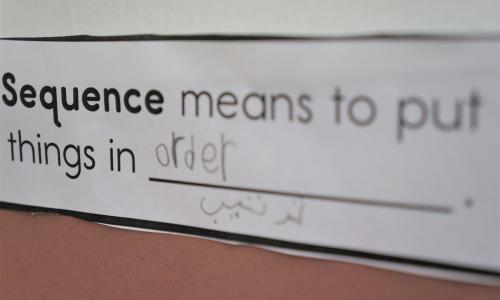Tips for Educators of ELLs: Teaching Vocabulary in Grades 4-12

Learn how educators in upper elementary, middle grades, and high school can back up their English learners' vocabulary evolution with these strategies.
Introduction
Research shows that vocabulary development is one of the about important skills students need to larn to become English-proficient. Here are some strategies to help you get started! These strategies are geared towards grades 4-12 simply tin can be adjusted for younger students.
Related resources
- Selecting Vocabulary Words to Teach English Language Learners
Vocabulary Strategies for Educators
Teach vocabulary in an explicit, systematic manner
Download these tips!
These tips are available as a one-page handout to download and print.
- Download PDF
Choose the vocabulary that your students nigh need to know in order to support their reading evolution and content area learning. Plan for repeated exposures to ensure mastery. When introducing new vocabulary be sure to provide pupil-friendly definitions for words important to the job at hand.
Teach vocabulary thematically
Organize vocabulary around a common theme, and choose reading materials that reinforce that vocabulary in context.
Teach vocabulary by focusing on mutual root words and affixes to expand word noesis
Learning near roots, prefixes, and suffixes is a great style to reinforce and expand ELLs' agreement of English words. Breaking the words downwards into smaller pieces makes unfamiliar words more comprehensible.
Capitalize on cognates
Teach students to make the connexion between words that are the same or similar in English and in their primary language, too called cognates. This is an easy manner to meliorate both vocabulary and reading comprehension.
Preview, preview, preview!
Earlier reading, pre-teach essential vocabulary and preview the content. "Walk" through the book or chapter, looking at the pictures and demonstrating how the previewed vocabulary is used in context since vocabulary is learned best through meaningful associations.
Teach and build academic vocabulary
English language learners need continued instruction in academic vocabulary as they meet new subjects and new ideas at the high school level. Work with colleagues to place and teach the vocabulary that ELLs demand in society to be successful readers and learners in each of their other classes.
Teach vocabulary specific to content
A educatee's maximum level of reading comprehension is determined by his or her knowledge of words. Teach key words that children will demand to comprehend texts, acquire the content in those texts, and pass tests.
Ensure that your students learn the following dimensions of new words:
- The power to ascertain a word
- The power to recognize when to use that word
- Knowledge of its multiple meanings
- The ability to decode and spell that word
Content-specific words include words such every bit 'photosynthesis', 'revolution', 'metaphor', and words with multiple meanings such as 'political party', 'mouse', 'table', etc.
Teach signal words and directional words in society to build a student's academic vocabulary
Assist ELLs learn how to recognize, understand, and use signal and directional words.
Signal words are sometimes called "transition" words and "indicate" relationships between clauses. They include cause and effect words ("therefore" and "considering"), comparison and contrast words ("despite" and "while", and time sequence words ("then and "before").
Directional words describe a language part students need to perform, such as "explain", "compare", "inform", "contrast", "persuade," "justify", etc.
Note: In J. Michael O'Malley & Lorraine Valdez Pierce'south book, Authentic Cess for English Learners, the academic and social linguistic communication functions are laid out in a clear chart.
Differentiate between different kinds of academic vocabulary and usage
Help ELLs understand how to recognize and when to use different kinds of academic vocabulary (content-specific words, bespeak words, etc.) by making clear and specific distinctions between the different kinds of academic words students demand to know for a specific topic.
Teach students how to employ context clues to discover word meaning
Evidence students how to determine more meaning based on the balance of the sentence or surrounding paragraphs.
Requite students multiple opportunities to work with vocabulary
This includes connecting vocabulary to personal feel, allowing students to apply their principal language to make associations, using cognates, practicing speaking, reading and writing, using artwork to stand for words, in addition to techniques such equally Total Concrete Response (TPR), which allows students to show what they know past acting it out.
Teach students to actively engage with vocabulary as they read
Underlining, highlighting, making notes, and listing unknown vocabulary words are just a few strategies that foster comprehension past helping ELLs actively appoint with text.
Back to Tiptop
Reprints
You lot are welcome to print copies or republish materials for not-commercial use every bit long as credit is given to Colorín Colorado and the author(s). For commercial employ, please contact [email protected]
rylandenalland1953.blogspot.com
Source: https://www.colorincolorado.org/article/tips-educators-ells-teaching-vocabulary-grades-4-12
0 Response to "Tips for Educators of ELLs: Teaching Vocabulary in Grades 4-12"
Post a Comment